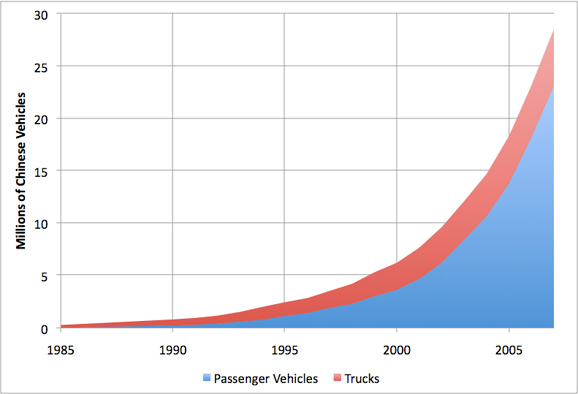Drive-Through Sit-In
In most places in the United States and, probably, the Western world, McDonald’s and other fast food joints have drive-throughs. Drive-throughs are a grossly convenient way to get a Filet-o-Fish or fries — drive around the building to that glowing menu sign, talk into the barely comprehendible squawk box, pull up a bit to the window, hand over a few bills, and take your sandwich. The hardest part may be navigating your beverage into the cup holder.
Simple, really — unless you’re in China, where the whole concept had to be explained.

For generations, the rank and file Chinese didn’t have cars. The growth of car ownership in China over recent years has been dramatic, as seen in the graph above (via here). That’s probably why, as of early 2008, only about two dozen of China’s 800 or so McDonald’s franchises had drive-through windows. The drive-through window may be second nature to us, but for the Chinese, it was anything but. According to a report by CNBC, Chinese motorists would drive to Mickey D’s, go to the drive-through, place their orders, and pay — just like everyone in the rest of the world — but instead of then going home or to work (or shamefully eating french fries alone in their car), they typically parked in the McDonald’s parking lot. And then, they went inside at sat in a booth, as if they had gotten their Whoppers Junior at the counter.
One theory as to why? The move was a calculated one, aimed at maximizing one’s value from the Extra Value Meals. At the time, McDonald’s was, shockingly, something of a delicacy in China. In a nation of over a billion people, 800 McDonald’s is surprisingly few, and that was because a $2 cheeseburger (or whatever was on the menu) was apparently outside of the price range acceptable to most household budgets. So to get one’s money’s worth, you really needed a comfy dining experience to go with your two all-beef patties on that sesame seed bun. Some patrons, however, believed that the drive-through was faster than waiting in line. Others didn’t like how their fellow customers cut the line inside, so they simply went to the much harder-to-cut line outside. In both cases, those customers wanted to sit, they just didn’t want to pay the typical way.
But the most likely explanation for this odd behavior was simply that few Chinese customers had any prior knowledge of drive-throughs and the never-leave-your-car takeout experience. As the CNBC article notes, during one of the reporter’s visits with a McDonald’s executive in China, a BMW owner entered the drive-through via the exit lane, and apparently, that wasn’t atypical. The executive noted that teaching McDonald’s employees about the workings of the drive-through was difficult enough, and they never expected to have to train their customers to use it — but apparently, they do. Hopefully, for McDonald’s sake, the learning curve for Chinese nationals to master how to use drive-through will be as rapid as the ascent of car ownership in the country.
Bonus Fact: According to McDonald’s official site, the first drive-through (in the U.S.) opened in 1975, in order to accommodate Americans who were serving in the military. Soldiers wearing fatigues were not allowed to wear their work uniforms when going out to lunch; the drive-through allowed them to pick up lunch without leaving the car and therefore, without violating the military’s rules.
From the Archives: Interstate Drive-Thru: The logistics of running a lot of drive-throughs (which I apparently spelled “thru” last time) through a central location.
Related: This is only tangentially related to the story above but it made me laugh and I kind of want one.
